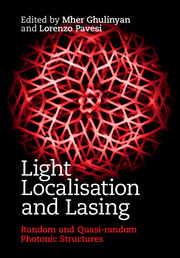Book contents
- Frontmatter
- Contents
- List of contributors
- Preface
- 1 Light propagation and emission in complex photonic media
- 2 Transport of localized waves via modes and channels
- 3 Modes structure and interaction in random lasers
- 4 Ordered and disordered light transport in coupled microring resonators
- 5 One-dimensional photonic quasicrystals
- 6 2D pseudo-random and deterministic aperiodic lasers
- 7 Three-dimensional photonic quasicrystals and deterministic aperiodic structures
- 8 Cavity quantum electrodynamics with three-dimensional photonic band gap crystals
- References
- Index
8 - Cavity quantum electrodynamics with three-dimensional photonic band gap crystals
Published online by Cambridge University Press: 18 December 2014
- Frontmatter
- Contents
- List of contributors
- Preface
- 1 Light propagation and emission in complex photonic media
- 2 Transport of localized waves via modes and channels
- 3 Modes structure and interaction in random lasers
- 4 Ordered and disordered light transport in coupled microring resonators
- 5 One-dimensional photonic quasicrystals
- 6 2D pseudo-random and deterministic aperiodic lasers
- 7 Three-dimensional photonic quasicrystals and deterministic aperiodic structures
- 8 Cavity quantum electrodynamics with three-dimensional photonic band gap crystals
- References
- Index
Summary
Introduction
The propagation of light in periodically ordered photonic crystals bears a strong analogy to the wave propagation of conduction electrons in atomic crystals. The development of Bloch modes and dispersion are determined by the interference of waves that are diffracted by lattice planes [19, 52]. The periodicity commensurate with the wavelength (a ≈ λ/2) gives rise to Bragg diffraction that is associated with frequency windows for which waves are forbidden to propagate in a particular direction. Such stop gaps have long been known to arise for electromagnetic waves, notably for X-rays in atomic crystals [214]. At optical frequencies, the stop gaps that occur in one-dimensional periodic structures, known as Bragg stacks, are widely used in optical laboratories as broadband highly reflecting dielectric mirrors [556].
The distinguishing feature of three-dimensional (3D) photonic crystals is that a common stop gap can be achieved for all directions and for all polarizations simultaneously: the widely pursued 3D photonic band gap. Historically a 3D band gap has never been considered for the propagation of X-rays in periodic media, since a gap requires a high refractive index contrast of order unity, whereas the refractive index varies by less then 10−4 in the X-ray range. At frequencies inside the 3D photonic band gap, the density of optical states (DOS) completely vanishes. As the density of states can also be interpreted as the density of vacuum fluctuations [334], a 3D band gap thus serves as an effective shield to these fluctuations. The total absence of optical modes in a photonic band gap has implications beyond classical optics that break the analogy between the behavior of light in photonic crystals and the behavior of electrons in atomic crystals.
3D photonic band gap crystals play an important role in cavity quantum electrodynamics (cQED) [64, 549], where they offer at least five prospects for new physics. Firstly, probably the most eagerly pursued phenomenon is the complete inhibition of spontaneous emission: an excited quantum emitter – such as an atom, molecule, or quantum dot – embedded in a crystal with its transition frequency tuned to within the 3D band gap remains forever excited since it cannot decay to the ground state by emitting a photon.
- Type
- Chapter
- Information
- Light Localisation and LasingRandom and Pseudo-random Photonic Structures, pp. 180 - 214Publisher: Cambridge University PressPrint publication year: 2014
- 2
- Cited by



